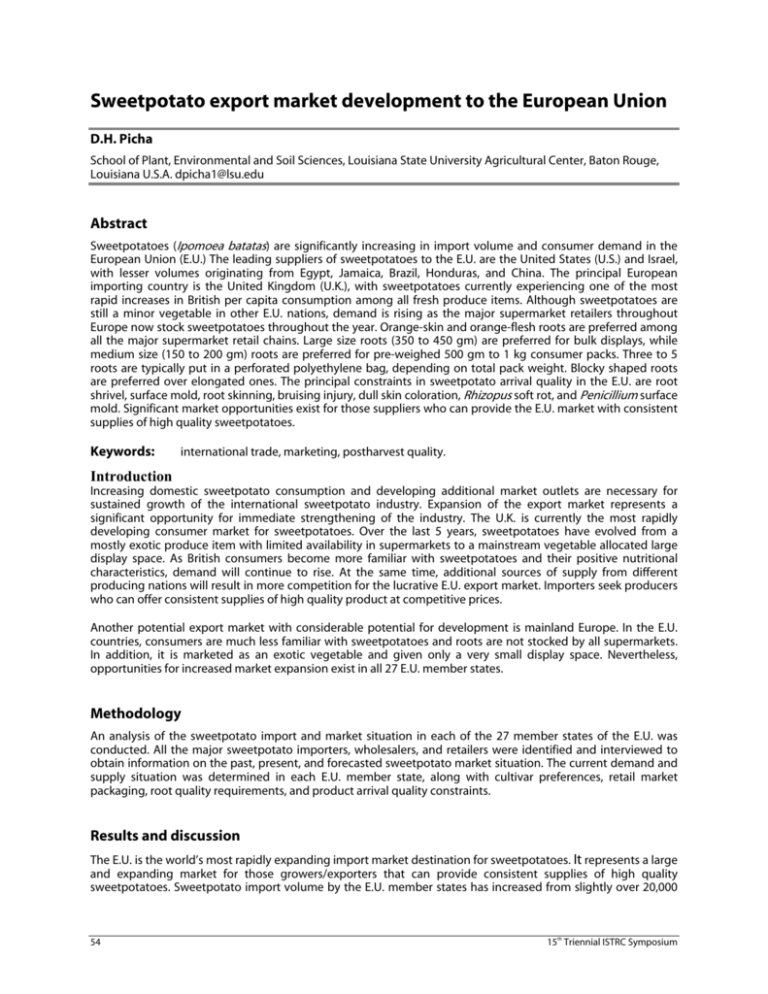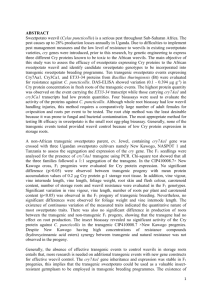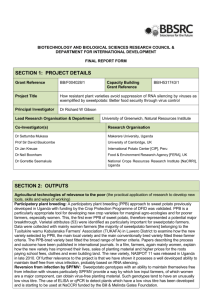Sweetpotato export market development to the European Union
advertisement

Sweetpotato export market development to the European Union D.H. Picha School of Plant, Environmental and Soil Sciences, Louisiana State University Agricultural Center, Baton Rouge, Louisiana U.S.A. dpicha1@lsu.edu Abstract Sweetpotatoes (Ipomoea batatas) are significantly increasing in import volume and consumer demand in the European Union (E.U.) The leading suppliers of sweetpotatoes to the E.U. are the United States (U.S.) and Israel, with lesser volumes originating from Egypt, Jamaica, Brazil, Honduras, and China. The principal European importing country is the United Kingdom (U.K.), with sweetpotatoes currently experiencing one of the most rapid increases in British per capita consumption among all fresh produce items. Although sweetpotatoes are still a minor vegetable in other E.U. nations, demand is rising as the major supermarket retailers throughout Europe now stock sweetpotatoes throughout the year. Orange-skin and orange-flesh roots are preferred among all the major supermarket retail chains. Large size roots (350 to 450 gm) are preferred for bulk displays, while medium size (150 to 200 gm) roots are preferred for pre-weighed 500 gm to 1 kg consumer packs. Three to 5 roots are typically put in a perforated polyethylene bag, depending on total pack weight. Blocky shaped roots are preferred over elongated ones. The principal constraints in sweetpotato arrival quality in the E.U. are root shrivel, surface mold, root skinning, bruising injury, dull skin coloration, Rhizopus soft rot, and Penicillium surface mold. Significant market opportunities exist for those suppliers who can provide the E.U. market with consistent supplies of high quality sweetpotatoes. Keywords: international trade, marketing, postharvest quality. Introduction Increasing domestic sweetpotato consumption and developing additional market outlets are necessary for sustained growth of the international sweetpotato industry. Expansion of the export market represents a significant opportunity for immediate strengthening of the industry. The U.K. is currently the most rapidly developing consumer market for sweetpotatoes. Over the last 5 years, sweetpotatoes have evolved from a mostly exotic produce item with limited availability in supermarkets to a mainstream vegetable allocated large display space. As British consumers become more familiar with sweetpotatoes and their positive nutritional characteristics, demand will continue to rise. At the same time, additional sources of supply from different producing nations will result in more competition for the lucrative E.U. export market. Importers seek producers who can offer consistent supplies of high quality product at competitive prices. Another potential export market with considerable potential for development is mainland Europe. In the E.U. countries, consumers are much less familiar with sweetpotatoes and roots are not stocked by all supermarkets. In addition, it is marketed as an exotic vegetable and given only a very small display space. Nevertheless, opportunities for increased market expansion exist in all 27 E.U. member states. Methodology An analysis of the sweetpotato import and market situation in each of the 27 member states of the E.U. was conducted. All the major sweetpotato importers, wholesalers, and retailers were identified and interviewed to obtain information on the past, present, and forecasted sweetpotato market situation. The current demand and supply situation was determined in each E.U. member state, along with cultivar preferences, retail market packaging, root quality requirements, and product arrival quality constraints. Results and discussion The E.U. is the world’s most rapidly expanding import market destination for sweetpotatoes. It represents a large and expanding market for those growers/exporters that can provide consistent supplies of high quality sweetpotatoes. Sweetpotato import volume by the E.U. member states has increased from slightly over 20,000 54 th 15 Triennial ISTRC Symposium metric tons in 1996 to over 65,000 metric tons in 2006. The demand for orange flesh type roots is fueling the significant increase in E.U. sweetpotato import volume. The U.K. is the leading European importing country, followed by the Netherlands and France, with similar import volumes (Table 1). Together, these three countries import over 80 % of the total E.U. sweetpotato import volume. However, a significant portion of the sweetpotato volume recorded as official imports into the Netherlands and France is re-exported to other European countries. In the case of Britain, nearly all of the sweetpotato import volume is consumed within the country. During the last 5-year period, a consistent trend in import volume has occurred in 20 out of the 27 countries in the E.U. The only countries which have not realized a sustained pattern of import growth are Italy, Germany, Austria, Greece, Malta, Lithuania, and Slovakia. Sweetpotato consumption is highest in the U.K., followed by the western European countries, and Scandinavia. Consumption remains very low in the eastern E.U. nations. Table 1. E.U. sweetpotato import volume by country (metric tons) Year Country 1996 U.K. 4,195 Netherlands 1,129 France 2,799 Italy 3,485 Spain 138 Belgium Germany 479 Finland 23 Portugal 147 Greece 328 Ireland 21 Sweden 97 Denmark 15 Poland 20 Austria 257 Czech Rep. 3 Slovenia 23 Cyprus Hungary 40 Luxembourg Estonia Bulgaria Latvia Romania 1,061 Malta Lithuania Slovakia 0 Belgium/Lux. 5,801 Total 20,061 source: EUROSTAT 1997 4,272 1,315 3,455 7,648 25 1998 5,065 1,081 4,356 15,931 11 1999 6,145 2,064 4,859 10,029 1,192 317 56 137 1265 29 42 14 136 82 6 0 603 103 115 465 26 128 18 6 247 7 0 447 117 176 1,539 129 113 31 50 244 12 0 4 7 27 1 0 0 0 1 1 433 1,430 2 286 19,525 13 123 29,736 0 379 27,554 2000 7,431 2,286 5,367 14,811 1,117 167 444 127 141 939 150 152 59 0 213 8 0 1 0 48 1 0 19 30 1 0 0 33,512 2001 9,604 3,034 5,121 10,595 1,041 282 912 177 442 469 270 105 41 120 238 13 1 5 7 17 1 0 9 18 4 2 0 32,528 2002 11,578 3,925 6,479 13,290 998 324 1,302 243 325 113 326 144 50 0 224 13 2 8 9 5 1 0 3 0 3 2 0 39,367 2003 13,290 4,970 6,591 5,305 899 360 713 332 293 1,266 351 114 87 0 256 14 0 10 0 5 1 1 3 0 6 8 3 2004 15,426 5,037 7,704 2,428 2,234 739 1,097 390 293 531 198 130 109 5 209 29 40 9 60 13 1 2 2 6 13 4 9 2005 25,382 7,360 7,804 2,968 1,712 1,442 1,034 539 1,966 249 365 141 88 468 130 57 14 21 0 8 9 4 3 1 4 4 0 2006 35,122 9,871 9,511 3,437 1,925 1,139 999 785 733 565 433 308 221 162 79 44 41 31 20 18 11 8 7 7 4 3 1 34,878 36,718 51,773 65,485 Sweetpotatoes are marketed through either retail or wholesale channels. The retail market channel dominates fresh produce sales in the E.U, with an estimated 80 % of the total volume. Within the retail market channel, the supermarkets and hypermarkets control the majority of the retail grocery trade. On average, they represent about 70 % of total E.U. retail sector trade, although this percentage varies between countries. The wholesale market channel is used in marketing an estimated 20 % of the sweetpotato volume in the E.U. However, the sweetpotato exporter to the E.U. can no longer rely on placing product into wholesale markets on a consignment basis as a sustainable marketing strategy. Within the wholesale market channel, the traditional wholesalers, who are typically located at or near the fresh produce terminal markets in the larger E.U. cities, and the foodservice distributors control the majority of the trade. The wholesalers are the main suppliers of produce to the catering distributors, who in turn provide produce items to the foodservice establishments, including restaurants, hotels, airlines, bars, cafes, schools, hospitals, prisons, and other institutions. Wholesale market merchants also provide sweetpotatoes to International Society for Tropical Root Crops (ISTRC) 55 independent grocers, street market vendors, and small shopkeepers. Demand for sweetpotatoes continues to grow within the catering segment, as the foodservice industry requires increasing amounts of convenient and ready-to-prepare/serve forms of sweetpotato. Orange flesh sweetpotatoes are the preferred type in this market segment, although significant volumes of white flesh roots are sold to independent grocers and ethnic market shop owners. The retail supermarket sector is the principal marketing channel for sweetpotatoes in the E.U. The U.K. supermarkets dominate all other E.U. retailers in import volume. All of the major British retail supermarket stores stock orange flesh sweetpotatoes on a year-round basis. In addition, the foodservice sector is utilizing increasing amounts of sweetpotatoes. In the U.K., four major supermarket chains (Tesco, Asda, Sainsburys, Morrisons) control nearly 75 % of total domestic retail produce sales. Three other retail chains (Somerfield, Waitrose, Marks & Spencer) control slightly over 10 % of British retail produce sales and also stock sweetpotatoes in their retail outlets year-round. Even the emerging discount retailers like Aldi and Lidl have begun to offer sweetpotatoes. Within the last 5 years in British supermarkets, sweetpotatoes have evolved from an exotic vegetable given limited shelf space, to a mainstream fresh produce item with large bulk and consumer pack displays. This represents a dramatic shift from the situation prior to 2002, in which few retailers stocked sweetpotatoes, and the ones who did offered mostly white flesh type roots. Sales of orange flesh sweetpotatoes have recently been one of the leading fresh produce growth items in the U.K. Continued market growth is projected, as consumers become more familiar with the product and its nutritional value, along with the multiple ways of preparing sweetpotatoes for consumption. Purple or white-skinned sweetpotato types with a white or cream flesh color have very limited demand in retail market outlets. The fresh produce category managers for the leading supermarket chains prefer only orange flesh roots. However, white or cream flesh root types are still popular within certain ethnic groups and are widely found in the wholesale markets, in ethnic-oriented grocery stores, on street markets, and in small shops frequented by immigrants from Asia, Africa, and the Caribbean. This demographic sector of the population comprises less than 5 % of the population, but has the highest per capita consumption of sweetpotatoes. Organically-grown sweetpotatoes constitute only a very small percentage of the E.U. sweetpotato market and are generally stocked by only a few retailers in the U.K. Nevertheless, this niche market item is experiencing a steady growth in demand. Although no official statistics are available on organic sweetpotato sales, trade sources interviewed indicated less than 3 % of all sweetpotato purchases are for organically-grown product. The market situation for sweetpotatoes in continental Europe is quite different than in the U.K. There is much less consumer familiarity with the product and the majority of mainland Europeans have never eaten a sweetpotato. Although sweetpotatoes are known and commonly consumed within various immigrant communities, the ethnic market comprises only a small percentage of overall fresh produce sales. Similar to the situation in the U.K., the retail supermarkets are the dominant market outlet for fruits and vegetables in continental Europe. Sweetpotatoes are typically available only in the exotics area of the fresh produce section of the largest supermarkets and hypermarket stores. Where available, they are typically presented only in small bulk displays. Mainland E.U. retailers do not market sweetpotatoes in consumer bags. Market growth for sweetpotatoes has occurred in mainland Europe and import volumes are increasing, but in smaller quantities and at a much slower rate compared to Britain. Regional differences in demand also exist. Sweetpotato consumption is higher in the western E.U. countries and Scandinavia, compared to the eastern E.U. and Baltic states. Nevertheless, the sweetpotato remains a minor vegetable in all of the E.U. member states outside of the U.K. Considerable opportunity exists to increase the market penetration and consumption of sweetpotatoes throughout the E.U. Although the demographics and per capita incomes vary between countries, urban populations in each of the E.U. countries represent significant potential growth market opportunities for sweetpotatoes. An analogous situation to what has occurred in the U.K. sweetpotato market this decade is possible within other E.U. countries. However, promotion, advertising, and product preparation information needs to be more widely disseminated in order to obtain significant market growth. Sweetpotatoes are not a domestically grown vegetable in most E.U. countries. Therefore, there is a lack of familiarity with this product among the consuming public. More awareness by consumers on the positive nutritional properties of sweetpotatoes will help to increase consumer demand. The forecast among importers and retailers in continental Europe is for continued growth in the sweetpotato market. 56 th 15 Triennial ISTRC Symposium Consistency of supply, high quality product, and competitive price offerings are three essential elements required for success in the E.U. export market. Service support, experience, and established marketing networks are also important. All the E.U. supermarket chains obtain their sweetpotatoes through an importer, rather than purchasing directly from the grower/exporter. However, the supermarket chains set their own grade standards and quality requirements which the importer must adhere to. All suppliers must be Global GAP certified in order to sell sweetpotatoes to the major European retail chains. The standard container used for marketing sweetpotatoes to E.U. wholesalers and retailers is the 6-kg corrugated carton. This is a widely used container in bulk displays of sweetpotatoes sold in the retail supermarkets. Some retailers also opt to transfer the roots from the 6-kg carton into re-usable plastic containers. Demand is strong for a diversity of root sizes, ranging from small 150-200 gm roots marketed in 500, 750, or 1,000 gm pre-packed bags to large-sized 400- 600 gm roots marketed individually in bulk displays. Three to 5 roots are typically put in a bag, depending on total weight. Blocky shaped roots are preferred over elongated ones, which are prone to tip breakage and concomitant decay. The foodservice (i.e. catering) sector in the U.K. also purchases extra-large roots (700-900 gm size) for minimally-processed products, including chips and fries. Competition among sweetpotato producing countries for the U.K. and continental E.U. export market is intense. The U.S. is the leading supplier, followed by Israel (Table 2). Both of these countries only export orange flesh roots. ‘Covington’ and ‘Beauregard’ are the main cultivars exported by U.S. growers, while ‘Georgia Jet’ is the primary cultivar supplied by Israeli growers. It is a low dry matter cultivar (typically between 15-16% dry matter) that is not amenable to long-term storage. The majority of the Israeli export volume occurs from August through February. Other countries which supply significant volumes of orange flesh roots to the E.U. are Honduras (Beauregard cultivar) and Egypt (Mabruka cultivar). In addition, China, Egypt, Brazil, South Africa, Jamaica, and Honduras are all suppliers of white or cream flesh sweetpotato types to the wholesale and ethnic markets. Minor quantities of white and orange flesh cultivars are sent to the E.U. from New Zealand, Peru, and Uganda. Among the E.U. nations, Spain and Italy are the leading producers, although production volume is limited and mostly confined to the fall season. Growers in Italy primarily produce white flesh roots, while Spanish growers produce orange flesh roots. Minor quantities of sweetpotatoes are also produced in Portugal and Greece. Table 2. Source of U.K. sweetpotato import volume Country of Origin 1996 U.S. 915 Israel 7 France 661 Egypt 229 Jamaica 1,058 Honduras South Africa 1,166 Brazil 4 Belgium-Luxembourg Netherlands 59 New Zealand Spain 67 Ghana China 0 Peru source: FAO Statistics Division 1997 1998 1,148 83 404 164 723 2,273 50 563 101 957 1,046 3 802 272 39 12 0 Year 1999 2000 Metric Tons 2,756 3,215 176 559 870 1,077 191 415 896 557 2001 2002 2003 2004 5,034 576 1,065 829 706 5,958 682 1,674 1,050 618 6,886 1,280 1,503 1,065 694 8,539 3,482 711 997 375 312 422 33 139 56 66 52 39 114 1 126 924 34 7 36 1,142 45 18 51 913 63 4 81 847 242 16 154 608 267 274 187 91 26 160 31 80 19 1 93 21 2 23 114 60 35 78 87 72 151 83 2005 13,885 6,101 1,466 875 541 401 372 337 314 309 278 244 136 76 The E.U. is an expanding market for sweetpotatoes and represents an excellent market opportunity for those producers capable of providing consistent supplies of high quality roots at competitive prices. It will be imperative for sweetpotato producers to continue to make improvements in cultural practices, postharvest care, and packing technologies in order to maximize the quantity of export quality roots. International Society for Tropical Root Crops (ISTRC) 57







